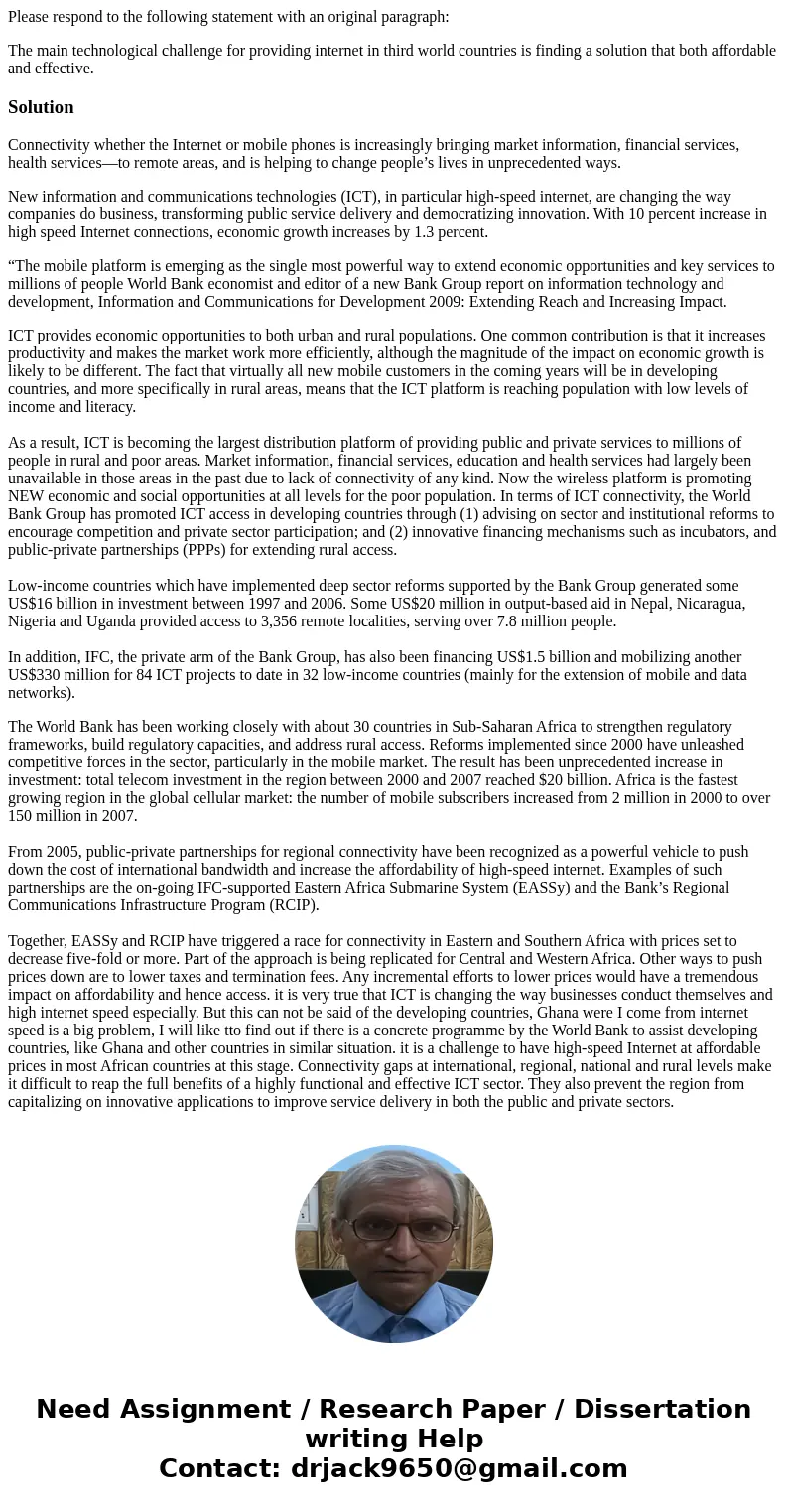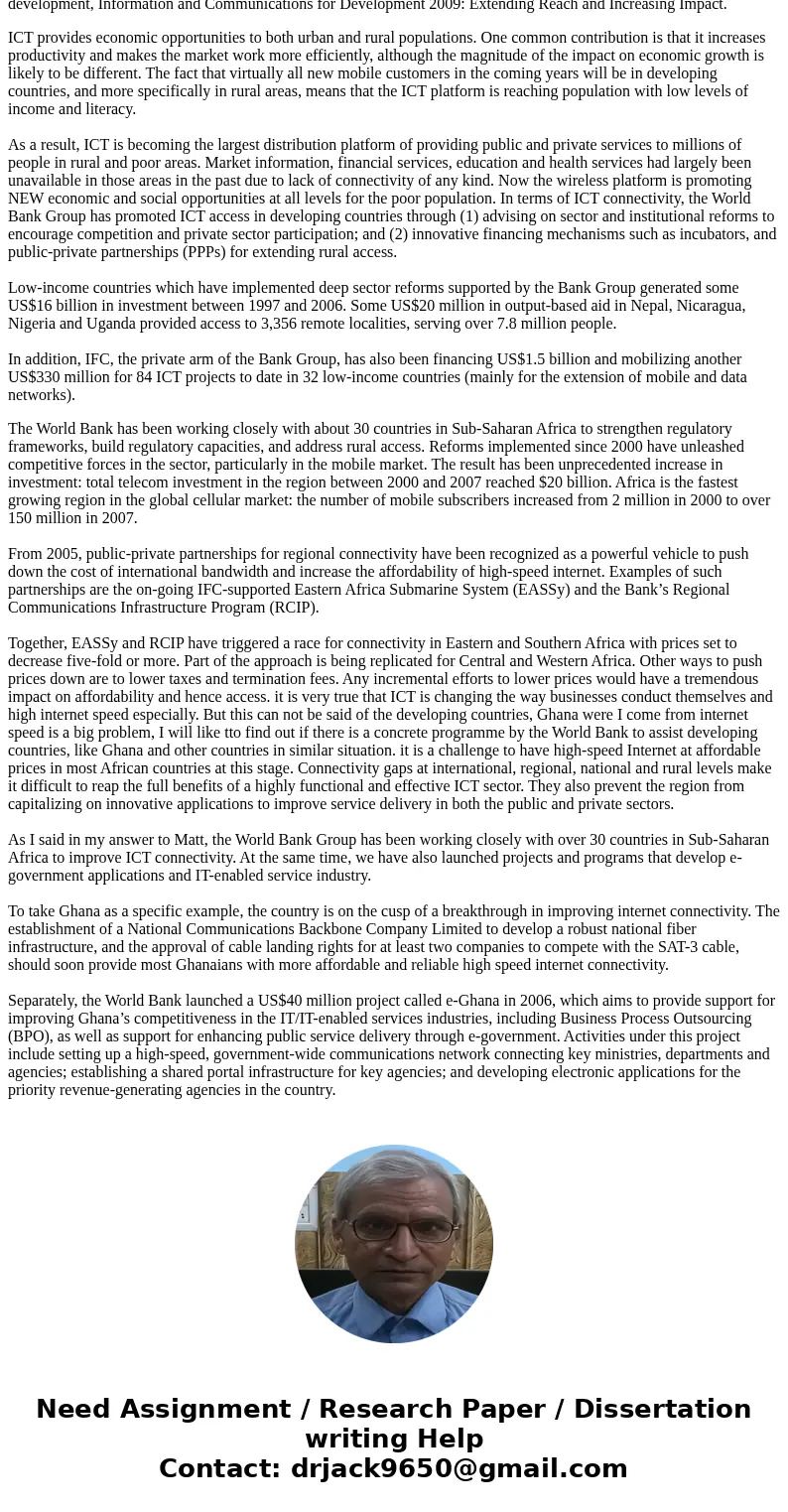Please respond to the following statement with an original p
Please respond to the following statement with an original paragraph:
The main technological challenge for providing internet in third world countries is finding a solution that both affordable and effective.
Solution
Connectivity whether the Internet or mobile phones is increasingly bringing market information, financial services, health services—to remote areas, and is helping to change people’s lives in unprecedented ways.
New information and communications technologies (ICT), in particular high-speed internet, are changing the way companies do business, transforming public service delivery and democratizing innovation. With 10 percent increase in high speed Internet connections, economic growth increases by 1.3 percent.
“The mobile platform is emerging as the single most powerful way to extend economic opportunities and key services to millions of people World Bank economist and editor of a new Bank Group report on information technology and development, Information and Communications for Development 2009: Extending Reach and Increasing Impact.
ICT provides economic opportunities to both urban and rural populations. One common contribution is that it increases productivity and makes the market work more efficiently, although the magnitude of the impact on economic growth is likely to be different. The fact that virtually all new mobile customers in the coming years will be in developing countries, and more specifically in rural areas, means that the ICT platform is reaching population with low levels of income and literacy.
As a result, ICT is becoming the largest distribution platform of providing public and private services to millions of people in rural and poor areas. Market information, financial services, education and health services had largely been unavailable in those areas in the past due to lack of connectivity of any kind. Now the wireless platform is promoting NEW economic and social opportunities at all levels for the poor population. In terms of ICT connectivity, the World Bank Group has promoted ICT access in developing countries through (1) advising on sector and institutional reforms to encourage competition and private sector participation; and (2) innovative financing mechanisms such as incubators, and public-private partnerships (PPPs) for extending rural access.
Low-income countries which have implemented deep sector reforms supported by the Bank Group generated some US$16 billion in investment between 1997 and 2006. Some US$20 million in output-based aid in Nepal, Nicaragua, Nigeria and Uganda provided access to 3,356 remote localities, serving over 7.8 million people.
In addition, IFC, the private arm of the Bank Group, has also been financing US$1.5 billion and mobilizing another US$330 million for 84 ICT projects to date in 32 low-income countries (mainly for the extension of mobile and data networks).
The World Bank has been working closely with about 30 countries in Sub-Saharan Africa to strengthen regulatory frameworks, build regulatory capacities, and address rural access. Reforms implemented since 2000 have unleashed competitive forces in the sector, particularly in the mobile market. The result has been unprecedented increase in investment: total telecom investment in the region between 2000 and 2007 reached $20 billion. Africa is the fastest growing region in the global cellular market: the number of mobile subscribers increased from 2 million in 2000 to over 150 million in 2007.
From 2005, public-private partnerships for regional connectivity have been recognized as a powerful vehicle to push down the cost of international bandwidth and increase the affordability of high-speed internet. Examples of such partnerships are the on-going IFC-supported Eastern Africa Submarine System (EASSy) and the Bank’s Regional Communications Infrastructure Program (RCIP).
Together, EASSy and RCIP have triggered a race for connectivity in Eastern and Southern Africa with prices set to decrease five-fold or more. Part of the approach is being replicated for Central and Western Africa. Other ways to push prices down are to lower taxes and termination fees. Any incremental efforts to lower prices would have a tremendous impact on affordability and hence access. it is very true that ICT is changing the way businesses conduct themselves and high internet speed especially. But this can not be said of the developing countries, Ghana were I come from internet speed is a big problem, I will like tto find out if there is a concrete programme by the World Bank to assist developing countries, like Ghana and other countries in similar situation. it is a challenge to have high-speed Internet at affordable prices in most African countries at this stage. Connectivity gaps at international, regional, national and rural levels make it difficult to reap the full benefits of a highly functional and effective ICT sector. They also prevent the region from capitalizing on innovative applications to improve service delivery in both the public and private sectors.
As I said in my answer to Matt, the World Bank Group has been working closely with over 30 countries in Sub-Saharan Africa to improve ICT connectivity. At the same time, we have also launched projects and programs that develop e-government applications and IT-enabled service industry.
To take Ghana as a specific example, the country is on the cusp of a breakthrough in improving internet connectivity. The establishment of a National Communications Backbone Company Limited to develop a robust national fiber infrastructure, and the approval of cable landing rights for at least two companies to compete with the SAT-3 cable, should soon provide most Ghanaians with more affordable and reliable high speed internet connectivity.
Separately, the World Bank launched a US$40 million project called e-Ghana in 2006, which aims to provide support for improving Ghana’s competitiveness in the IT/IT-enabled services industries, including Business Process Outsourcing (BPO), as well as support for enhancing public service delivery through e-government. Activities under this project include setting up a high-speed, government-wide communications network connecting key ministries, departments and agencies; establishing a shared portal infrastructure for key agencies; and developing electronic applications for the priority revenue-generating agencies in the country.


 Homework Sourse
Homework Sourse